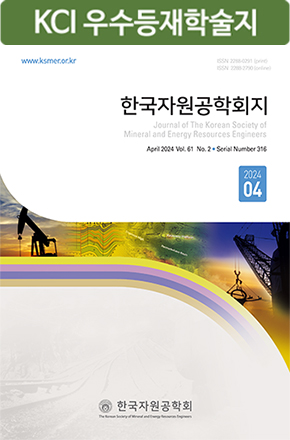- 김대형, 김지환, 이현복, 2008, “‘제3차 해외자원개발 기본 계획’의 주요 내용,” 한국지구시스템공학회지, 제 45권 2호, pp. 140-145.
- 박형동, 최요순, 현창욱, 장윤섭, 서장원, 2010, GIS 원리와 활용, 시그마프레스, 서울, p. 273.
- 선우춘, 최요순, 박형동, 정용복, 2007, “GIS에 의한 대규모 노천광에서의 배수처리 및 사면안정 예측,” 터널과 지하공간 (한국암반공학회지), 제 17권, pp. 360-371.
- 지식경제부, 2011, 2011년 광물자원 투자전망, http://www.mke.go.kr/news/bodo/bodoView.jsp?pCtx=1&seq=66102, Cited 2 March 2011.
- 최요순, 선우춘, 박형동, 2006, “광해방지를 위한 대규모 석탄 노천광의 배수설계 최적화,” 한국지구시스템공학회지, 제 43권, 5호, pp. 429-438.
- 한국지질자원연구원, 2007, 대규모 석탄 노천광의 연약사면 안정성 및 생산성 향상 연구, p. 195.
- 한국지질자원연구원, 2008, 대규모 석탄 노천광의 연약사면 안정성 및 생산성 향상 연구, p. 187.
- Ayad, Y., 2006, “Prioritizing acid mine drainage stream remediation,” In: ESRI (eds), GIS Best Practices: Mining, http://www.esri.com/library/bestpractices/mining.pdf, Cited 14 December 2010.
- Bruns, D.A. and Sweet, T., 2004, “Geospatial tools to support watershed environmental monitoring and reclamation: assessing mining impacts on the Upper Susquehanna-Lackawanna American Heritage River,” Proceedings of Advanced Integration of Geospatial Technologies in Mining and Reclamation, December 7-9, 2004, Atlanta, GA, http://www.tips.osmre.gov/GeoSpatial/post-conference/Papers/Bruns_Sweet1_PA.pdf, Cited 21 April 2009.
- Callow, J.N. and Smettem, K.R.J., 2009, “The effect of farm dams and constructed banks on hydrologic connectivity and runoff estimation in agricultural landscapes,” Environmental Modelling & Software, Vol. 24, pp. 959-968.
- Choi, Y., Park, H.D. and Sunwoo, C., 2008, “Flood and gully erosion problems at the Pasir open pit coal mine, Indonesia: a case study of the hydrology using GIS,” Bulletin of Engineering Geology and the Environment, Vol. 67, pp. 251-258.
- Choi, Y., Yi, H. and Park, H.D., 2011, “A new algorithm for grid-based hydrologic analysis by incorporating stormwater infrastructure,” Computers & Geosciences (in-press), http://dx.doi.org/10.1016/j.cageo.2010.07.008.
- Doan, J.H., 2000, “Hydrologic model of the Buffalo Bayou using GIS,” In: Maidment, D. R. and Djokic, D. (eds), Hydrologic and hydraulic modeling support with geographic information systems, ESRI Press, Redland, USA, pp. 113-144.
- Diaz-Nieto, J., Blanksby, J., Lerner, D.N. and Saul, A.J., 2008, “A GIS approach to explore urban flood risk management,” Proceedings 11th International Conference on Urban Drainage, Edinburgh, Scotland, UK. pp. 1-10, http://www.sbe.hw.ac.uk/staffprofiles/A/bdgsa/11th_International_Conference_on_Urban_Drainage_CD/ICUD08/pdfs/653.pdf, Cited 2 March 2011.
- Fletcher, J.J., Eli, R.N., Strager, M.P., Sun, Q., Churchill, J.B., Lamont, S.J., Galya, T.A. and Schaer, A.N., 2004, “The Watershed Characterization and Modeling System (WCMS): support tools for large watershed CHIA and NPDES analyses,” Proceedings of Advanced Integration of Geospatial Technologies in Mining and Reclamation, December 7-9, 2004, Atlanta, GA, http://www.tips.osmre.gov/GeoSpatial/post-conference/Papers/Fletcher2_WV_FINAL.pdf, Cited 21 March 2009.
- Jenson, S.K. and Domingue, J.O., 1988, “Extracting topographic structure from digital elevation data for geographic information system analysis,” Photogrammetric Engineering & Remote Sensing, Vol. 54, pp. 1593-1600.
- Mark, D.M. 1984, “Automated detection of drainage networks from digital elevation models,” Catographca, Vol. 21, pp. 168-177.
- Martz, L.W. and deJong, E., 1988, “CATCH: A FORTRAN program for measuring catchment area from digital elevation models,” Computers & Geosciences, Vol. 14, pp. 627-640.
- Martz, L.W. and Garbrecht, J., 1999, “An outlet breaching algorithm for the treatment of closed depressions in a raster DEM,” Computers & Geosciences, Vol. 25, pp. 835-844.
- Schauble, H., Marinoni, O. and Hinderer, M., 2008, “A GIS-based method to calculate flow accumulation by considering dams and their specific operation time,” Computers & Geosciences, Vol. 34, pp. 635-646.
- Tribe, A., 1992, “Automated recognition of valley lines and drainage networks from grid digital elevation models: a review and a new method,” Journal of Hydrology, Vol. 139, pp. 263-293.
- Wang, L. and Liu, H., 2006, “An efficient method for identifying and filling surface depressions in digital elevation models for hydrologic analysis and modeling,” International Journal of Geographical Information Science, Vol. 20, pp. 193-213.
- Wright, W.G., Simon, W., Bove, D.J., Mast, M.A. and Leib, K.J., 2007, “Distribution of pH values and dissolved trace-metal concentrations in streams,” In: Church, S. E., von Guerard, P. and Finger, S. E. (eds), Integrated investigations of environmental effects of historical mining in the Animas River Watershed, San Juan County, Colorado, U.S. Geological Survey Professional Paper 1651. pp. 497-541.
- Publisher :The Korean Society of Mineral and Energy Resources Engineers
- Publisher(Ko) :한국자원공학회
- Journal Title :Journal of the Korean Society for Geosystem Engineering
- Journal Title(Ko) :한국지구시스템공학회지
- Volume : 48
- No :2
- Pages :165-177



 Journal of the Korean Society of Mineral and Energy Resources Engineers
Journal of the Korean Society of Mineral and Energy Resources Engineers








